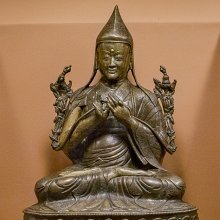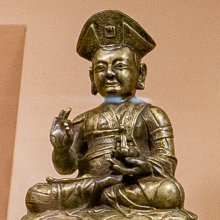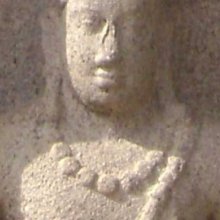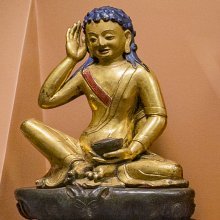Portrait: 2 definitions
Introduction:
Portrait means something in Hinduism, Sanskrit, the history of ancient India. If you want to know the exact meaning, history, etymology or English translation of this term then check out the descriptions on this page. Add your comment or reference to a book if you want to contribute to this summary article.
Images (photo gallery)
(+8 more images available)
In Hinduism
Shilpashastra (iconography)
Source: Shodhganga: Elements of Art and Architecture in the Trtiyakhanda of the Visnudharmottarapurana (shilpa)Portraits in ancient Indian Painting (citra), have been elaborately discussed in the Viṣṇudharmottarapurāṇa, an ancient Sanskrit text which (being encyclopedic in nature) deals with a variety of cultural topics such as arts, architecture, music, grammar and astronomy. In the third part of the Viṣṇudharmottarapurāṇa, nine chapters i.e., chapters from 35th to 43rd are dedicated to Painting where portraits of different kinds of men and women, natural objects and phenomena, different kinds of places, symbolization in Painting, personification in Painting etc. have been elaborately discussed. In the Viṣṇudharmottarapurāṇa, a specific measurement of every limb of a man as well as of a woman is elaborately and systematically discussed.

Shilpashastra (शिल्पशास्त्र, śilpaśāstra) represents the ancient Indian science (shastra) of creative arts (shilpa) such as sculpture, iconography and painting. Closely related to Vastushastra (architecture), they often share the same literature.
India history and geography
Source: Singhi Jain Series: Ratnaprabha-suri’s Kuvalayamala-katha (history)Portraits in ancient India were commonly painted according to the rules of Citrasūtra, as vividly depicted in the Kathās (narrative poems) such as Uddyotanasūri in his 8th-century Kuvalayamālā (a Prakrit Campū, similar to Kāvya poetry).—Page 233.7: There is a mention of a young painter bringing a cloth-painting on which was depicted the portrait of the daughter of the king of Ujjayinī. The painting was marked with the purity of lines, richness of colours, according to different compositions, beautiful stripling or seedling to show the effect of surroundings or high and low surfaces and right measurements and representation of different lines of painting like sādṛśya. [...]

The history of India traces the identification of countries, villages, towns and other regions of India, as well as mythology, zoology, royal dynasties, rulers, tribes, local festivities and traditions and regional languages. Ancient India enjoyed religious freedom and encourages the path of Dharma, a concept common to Buddhism, Hinduism, and Jainism.
See also (Relevant definitions)
Full-text (+153): Citralekha, Citraputrika, Tasavira, Upamatri, Citrakriti, Sadrishya, Duhasabi, Alekhya, Chayarupa, Patavidye, Varnakarma, Cittagara, Pata, Citradhara, Shabiha, Citraputrikay, Piratimai, Kushalacitra, Shabih, Avasheshita.
Relevant text
Search found 67 books and stories containing Portrait; (plurals include: Portraits). You can also click to the full overview containing English textual excerpts. Below are direct links for the most relevant articles:
Our Forum < [November-December 1932]
'The Triple Stream' < [November-December 1934]
South Indian Portraits < [January, 1928]
Later Chola Temples (by S. R. Balasubrahmanyam)
Temples in (Ten-) Tiruvalangadu < [Chapter XII - Temples of Kulottunga III’s Time]
Temples in Melaperumballam < [Chapter IV - Temples of Vikrama Chola’s Time]
Early Chola Temples (by S. R. Balasubrahmanyam)
Temples in Konerirajapuram (3rd year or earlier) < [Chapter X - Historical Survey]
Temples in Tiruvaduturai (3rd to 25th year) < [Chapter X - Historical Survey]
Temples in Tiruvaduturai (3rd to 25th year) < [Chapter X - Historical Survey]
Dasarupaka (critical study) (by Anuru Ranjan Mishra)
Part 13 - Status of Women in the Rukmiṇīharaṇa < [Chapter 9 - Īhāmṛga (critical study)]
Part 2 - Summary of the drama (Rukmiṇīharaṇa) < [Chapter 9 - Īhāmṛga (critical study)]
Part 7 - Characters in the Rukmiṇīharaṇa < [Chapter 9 - Īhāmṛga (critical study)]
Egypt Through The Stereoscope (by James Henry Breasted)
Position 11 - The Famous Wooden Statue Called The Shekh El-beled, In The Cairo Museum < [Standpoints In Egypt]
Position 95 - The Sixty-five-foot Portrait Statues Of Ramses Ii, Before The Rock-hewn Temple Of Abu Simbel < [Standpoints In Egypt]
Position 27 - The Great Sphinx Of Gizeh, The Largest Royal Portrait Ever Hewn < [Standpoints In Egypt]
Vishnudharmottara Purana (Art and Architecture) (by Bhagyashree Sarma)
7(a): Portrait of Men and Women < [Chapter 5 - Painting and Image Making]
7(c): Natural Objects and Phenomenon in Painting < [Chapter 5 - Painting and Image Making]
Related products







